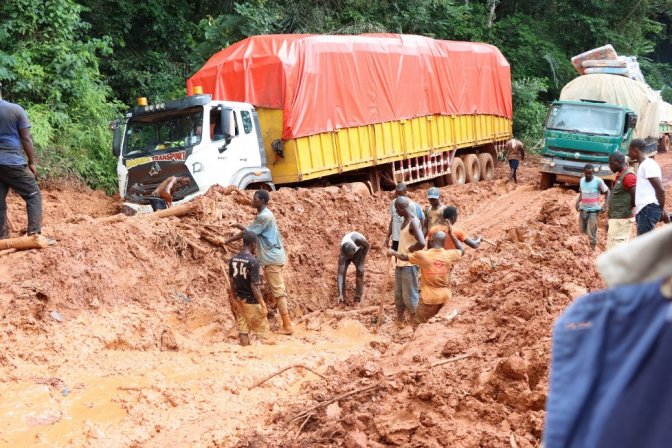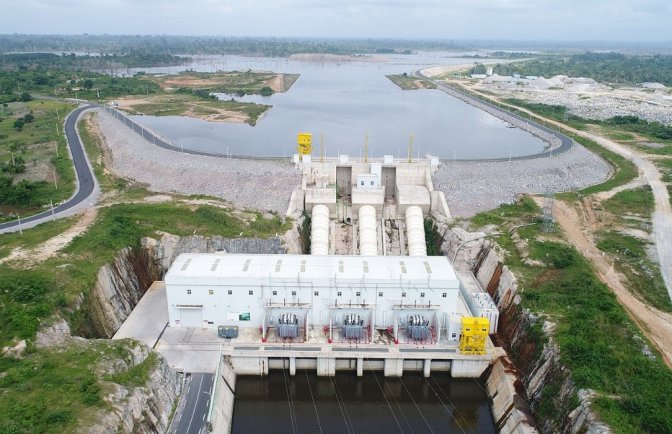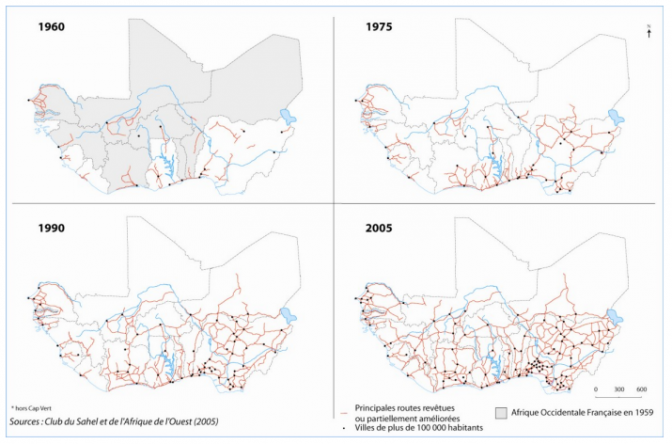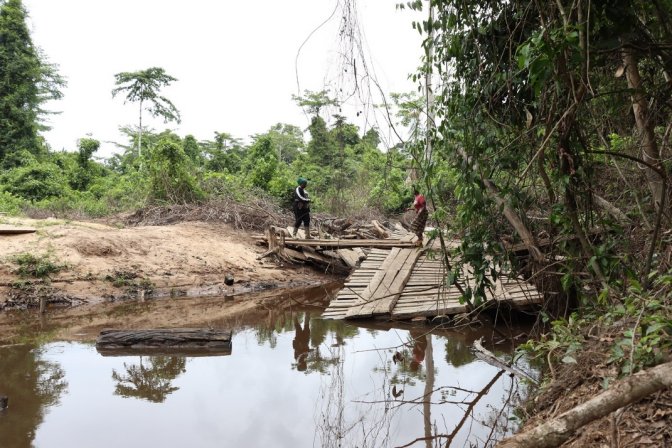Home / Guinean forests / Threats / Major infrastructure
Major infrastructure
Development of West African forest countries requires new infrastructure, to cover urbanisation, transport networks and energy production.
In the Guinean forests, in particular, access roads such as highways and railways are being created to open up the forest areas, and hydroelectric facilities are being built for energy supply.
Highways and railways
Highways and railways are being built to improve the means of communication for rural communities and to access the natural resources being mined or harvested in these remote areas.

The direct impacts of road and rail infrastructure on forest cover are relatively moderate in terms of area, with a maximum width of a few dozen metres. Their indirect impacts, on the other hand, represent a major threat:
- habitat loss, degradation and fragmentation for many animal species;
- creating access to previously sparsely inhabited forest areas, which facilitates the transport of agricultural and forest products (wood, but also bushmeat, fruit, etc.);
- human migration to forests where new economic activities are being developed, which leads to the clearing of forest areas for food crops, an increase in hunting for local consumption and increased exploitation of timber and firewood;
- the proliferation of invasive alien plant species, such as the most common in West Africa, Chromolaena odorata, better known as ‘Lao grass’, even though it originates from South America. This forms dense bushes that prevent other plant species from growing. The problem of invasive alien species is considered to be the second greatest cause of biodiversity loss globally, after the loss of natural habitats.
When roads and railways are poorly constructed or maintained, this can also lead to degradation of certain ecosystems, mainly through lack of drainage (accumulation of water causing a dam effect) or through erosion (increased runoff, in flow and sediment).
Dams
Numerous hydroelectric power structures are being built to address the need for energy for development. These structures, such as reservoir dams or hydroelectric dams, result in the destruction of thousands of hectares of forest.
By flooding large areas of rainforest, dams reduce the habitat of local wildlife and release carbon into the atmosphere (as the submerged wood rots), increasing the greenhouse gases that cause climate change.

Hydroelectric power plants also have a well-known negative impact on fish populations. They destroy aquatic habitats and create barriers that isolate populations from each other and prevent the movement of migratory species. Their construction often results in a reduction in numbers and loss of diversity and impacts on local communities that rely on fishing for food and income.
Urban areas
Linked to population growth, urban expansion has a direct impact on forests, due to deforestation around the urban areas to enable expansion. It also has an indirect impact due to the increased need for fuelwood and agricultural products to feed the urban population.
Selected major infrastructure in the Guinean forests
Railways to access mineral deposits at the expense of Guinean forests
The South Simandou and Mount Nimba iron ore deposits are located in landlocked areas far from the coast, making it difficult to extract and transport the ore.
The iron reserves are located on the border between Guinea, Liberia and Côte d’Ivoire.
Rail mega-projects are expected to emerge in the coming years with options to transport the minerals to the Guinean, Liberian and even Ivorian coasts.
They will be designed not only to shift the iron ore, but also other mineral, agricultural and forestry resources collected along the routes from the mines to the ports.
The direct and indirect impacts on the forest area would be unprecedented and without careful consideration of the social and environmental impacts of such large infrastructure projects.
Balancing energy for development with environmental and social sustainability
Liberia is starting out on the Gbedin Falls hydroelectric project with the construction of a mini dam on the Saint John River and the Gbedin waterfalls mini hydro power plant in Nimba County, northeast Liberia.
Key biodiversity areas and protected areas in the vicinity are:
- Diécké classified forest in Guinea, also an Important Bird Area (IBA);
- Gba Community Forest in Liberia;
- East Nimba Nature Reserve in Liberia;
- Mount Nimba Strict Nature Reserve in Guinea and Côte d’Ivoire, a UNESCO World Heritage Site;
- Banie classified forest in Guinea;
- the Gbedin RAMSAR wetland south of the Gbedin Falls.
The dam is expected to have a capacity of about 9 MW, which will serve as a source of energy in the region and increase the national electricity supply.
Direct environmental impacts are expected over an area of 22 hectares, as well as a penstock (enclosed pipe system) of about 100 metres from the falls to the hydroelectric power plant with its turbines.
The electricity generated by the plant will supply several thousand homes and connect remote and isolated areas to the national grid, providing power to more homes, schools, health centres, businesses and industries.
The indirect impacts will be considerable. It is therefore necessary to link energy infrastructure with effective and operational environmental and social management and monitoring plans.
An increasingly dense network of major roads in Guinean forests
In little more than half a century, the network of major roads has developed considerably, as shown below from 1960 to 2014.
The West African forest zone has been particularly affected, with direct and indirect impacts on the biodiversity of Guinean forests.
This web of major roads contributes to the loss, degradation and fragmentation of Guinean forests. Establishing priority conservation landscapes (PCLs) makes sense here. PCLs are composed of protected areas linked and connected to each other by ecological corridors, in order to preserve large areas of relatively intact and representative forest and emblematic animal species. (Add link to dedicated section).



